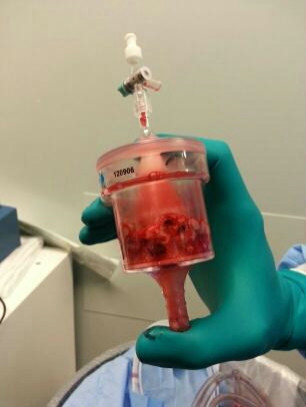2-Foot Blood Clot ‘Vacuumed’ Out Of Todd Dunlap, Clogged Heart Like A ‘Wad Of Gum In A Pipe’ [PHOTO]

When Todd Dunlap went to the emergency room he was tired, short of breath and extremely cold.
Only after a CT scan did doctors discover the root of his discomfort: a 2-foot blood clot stretching from his leg into his heart. When faced with the option of open-heart surgery or a less-invasive procedure that would vacuum the clot out of his heart, the 62-year-old chose the latter.
"The AngioVac was the last resort for Mr. Dunlap," Dr. John Moriarty of Los Angeles’ Ronald Reagan UCLA Medical Center said, describing the procedure, which had never been successfully performed in California. "The clot clogged his heart chamber like a wad of gum in a pipe. Every moment that passed increased the risk that the clot would migrate to his lungs and kill him."
The device called AngioVac is designed to pull blood out of veins and remove obstructions such as clots and tumors. The surgery involved sliding a camera down Dunlap’s throat to visually monitor his heart. Then, surgeons guided a hose down his neck artery, plugged one end into his heart, another though a vein at the groin, and hooked up the hose to a heart bypass device that created enough suction to pull the two-foot-long blood clot out.
"This stretches out and grabs the clot. It grabs it tightly because then we attach it to a very powerful suction," Moriarty told ABC News about the Aug. 14 surgery.
While this is the first time California doctors successfully performed the procedure, the technique has been used in New York, Pennsylvania and Germany, Popular Science reports.
As for Dunlap, a new grandfather, he’s happy with his decision. "I'm thrilled that I didn't have to go through open-heart surgery," Dunlap said. "This procedure is a great option for the older, frail person who wouldn't survive open-heart surgery. Without an alternative like this, he's a goner."
Within four days Dunlap was able to go home. Now, he’s back to his full-time role as a grandfather. "Now since I've had my procedure, my energy is better. It's really good to be able to play with [my grandson] now," he said.
Dunlap’s blood clot was caused by deep vein thrombosis, a condition where a blood clot forms in a deep vein, usually in the lower leg, thigh or pelvis. The often-underdiagnosed condition affects 300,000 to 600,000 Americans each year. Somewhere from 10 percent to 30 percent of people will die within one month of diagnosis, according to the U.S. Centers for Disease Control.
© Copyright IBTimes 2024. All rights reserved.




















